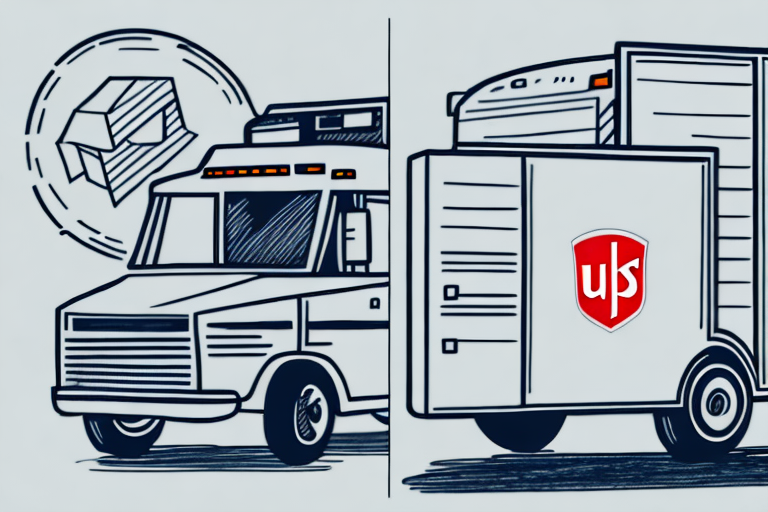Understanding the Difference Between UPS and USPS
When it comes to shipping and delivery services in the United States, two of the most popular options are UPS and USPS. Both have their own unique offerings and pricing structures, so it’s important to understand the differences before deciding which option is best for your needs. In this article, we’ll go over everything you need to know about UPS and USPS, from their services and pricing to their delivery time frames and insurance policies.
What is UPS and USPS?
UPS, or United Parcel Service, is a private shipping and logistics company that operates globally. They offer a wide range of services, from ground shipping to air delivery, as well as logistics and supply chain management solutions. UPS is known for its reliable delivery and efficient tracking system, making it a popular choice for businesses and individuals alike.
On the other hand, USPS, or the United States Postal Service, is a public agency of the federal government. It is responsible for delivering mail and packages to every residential and business address in the US, including remote areas and military bases. USPS offers a variety of services, including priority mail, first class mail, and media mail, and is often preferred by those looking for a more affordable shipping option.
While both UPS and USPS offer shipping and delivery services, there are some key differences between the two. One major difference is that UPS is a private company, while USPS is a government agency. This means that UPS has more flexibility in terms of pricing and services offered, but USPS is required to provide universal service to all addresses in the US, regardless of profitability. Additionally, UPS tends to be more expensive than USPS, but offers faster delivery times and more advanced tracking options. Ultimately, the choice between UPS and USPS depends on your specific shipping needs and budget.
How do UPS and USPS differ in terms of services offered?
One of the biggest differences between UPS and USPS is the range of services each offers. UPS provides a wider range of shipping options, including ground, air, and international shipping, as well as additional services such as logistics and supply chain management. USPS, on the other hand, focuses primarily on mail and package delivery, with fewer options for international shipping and other services.
Another key difference between UPS and USPS is their delivery speed. UPS offers guaranteed delivery times for their services, such as next-day or two-day delivery, while USPS does not guarantee delivery times for their standard services. Additionally, UPS offers more advanced tracking and notification options for their packages, allowing customers to track their shipments in real-time and receive updates on delivery status.
Comparing prices between UPS and USPS
Pricing is another area where UPS and USPS differ. UPS generally has higher shipping rates than USPS, but this is offset by their faster and more reliable delivery times. USPS offers more affordable rates, but their delivery times can be longer and less predictable. In general, it’s best to compare prices for your particular shipping needs to determine which option is the most cost-effective for you.
It’s important to note that both UPS and USPS offer various shipping options that can affect pricing and delivery times. For example, UPS offers guaranteed overnight and two-day shipping, which can be more expensive than their standard ground shipping. USPS also offers priority and express mail options for faster delivery, but these come at a higher cost. When comparing prices, be sure to consider the specific shipping options and delivery times that best fit your needs.
Which one is more reliable: UPS or USPS?
When it comes to reliability, UPS has a stronger reputation for timely and secure delivery. They have a more advanced tracking system that allows customers to monitor their shipments in real-time, and they also offer guaranteed delivery times for certain services. USPS, while generally reliable, can be subject to variable delivery times and unexpected delays, particularly during peak shipping seasons.
However, USPS does have some advantages over UPS. For one, USPS is often more affordable, especially for smaller packages and for shipping to rural areas. Additionally, USPS offers a wider range of shipping options, including flat-rate boxes and envelopes, which can be a convenient and cost-effective choice for certain shipments.
Another factor to consider is the environmental impact of shipping. UPS has made significant efforts to reduce their carbon footprint, including investing in alternative fuel vehicles and implementing more efficient delivery routes. USPS has also taken steps to reduce their environmental impact, such as offering eco-friendly shipping supplies and using renewable energy sources in some of their facilities.
Understanding the delivery time frames of UPS and USPS
As mentioned, UPS generally offers faster delivery times than USPS. Their ground shipping option typically takes 1-5 business days for delivery within the US, while their air shipping can be as fast as next-day delivery. USPS delivery times can vary significantly depending on the service selected and other factors such as location and weather.
It’s important to note that both UPS and USPS offer tracking services for their packages. This allows customers to monitor the progress of their shipment and receive updates on any delays or changes in delivery time. Additionally, both companies offer options for expedited shipping for those who need their packages delivered quickly. However, it’s important to keep in mind that expedited shipping options can be more expensive than standard shipping.
How to track your package with UPS and USPS
Both UPS and USPS offer online tracking tools that allow you to monitor your package’s progress from shipment to delivery. For UPS, simply enter your tracking number on their website or mobile app to see the live status of your shipment. USPS also has an online tracking system that provides updates on delivery times and locations, as well as alerts for any potential delays or issues.
It’s important to note that both UPS and USPS also offer additional services to help ensure the safe and timely delivery of your package. UPS, for example, offers options such as signature confirmation and insurance to protect your shipment. USPS offers similar services, including priority mail and certified mail, which provide added security and tracking capabilities.
Another useful feature of both UPS and USPS tracking systems is the ability to receive notifications via email or text message. This allows you to stay up-to-date on the status of your package without having to constantly check the tracking website. Simply set up your notification preferences and you’ll receive alerts for any updates or changes to your shipment.
The benefits of using UPS over USPS
One of the main benefits of using UPS is their speed and reliability. They also offer a wider range of shipping options and services, as well as more advanced tracking and delivery notification tools. Additionally, UPS has a strong reputation for excellent customer service and support.
Another advantage of using UPS is their global reach. They have a vast network of international partners and can deliver to over 220 countries and territories worldwide. This makes them an ideal choice for businesses that need to ship products internationally.
Furthermore, UPS has a range of sustainability initiatives in place, such as their carbon-neutral shipping option and their use of alternative fuel vehicles. This makes them a more environmentally friendly option compared to USPS, which has been criticized for its carbon footprint and lack of sustainable practices.
The benefits of using USPS over UPS
While USPS may be less expensive than UPS, they also offer some benefits that make them a preferred choice for many. USPS is available for package delivery to every residential and business address in the US, including remote and rural areas. They also offer international shipping and flat-rate pricing on many packages, which can make it a more affordable option for certain shipments.
In addition to their wide availability and affordable pricing, USPS also offers a range of convenient services. For example, they offer free package pickup from your home or office, as well as the ability to schedule a package pickup online. They also provide tracking information for all packages, so you can easily monitor the progress of your shipment.
Another benefit of using USPS is their commitment to sustainability. They have implemented a number of eco-friendly initiatives, such as using alternative fuel vehicles and reducing their carbon footprint. By choosing USPS, you can feel good about supporting a company that is working to reduce its impact on the environment.
Understanding the shipping restrictions of UPS and USPS
Both UPS and USPS have shipping restrictions in place for certain types of items, such as hazardous materials or weapons. It’s important to be aware of these restrictions when choosing your shipping method, as violating them can result in legal consequences.
International shipping with UPS vs. USPS
For international shipping, UPS is generally considered the more reliable and efficient option. They offer a wider range of international shipping services, including air and ocean freight, and can provide customs clearance services to facilitate the shipping process. USPS also offers international shipping, but their delivery times and tracking options can be less predictable than UPS.
Choosing between UPS and USPS for your small business needs
When selecting a shipping provider for your small business, there are several factors to consider, including pricing, delivery times, and shipping options. UPS may be a more reliable and efficient option for businesses with higher shipping volumes or those shipping to remote locations or internationally. USPS can be a more affordable option for smaller businesses or those shipping primarily within the US.
Tips for selecting the best shipping option - UPS or USPS
To choose the best shipping option for your needs, consider factors such as shipping rates, delivery times, and available services. Assess your shipping needs and compare prices for both UPS and USPS to determine which option is the most cost-effective and efficient for your particular shipment.
Customer service comparison between UPS and USPS
In terms of customer service, both UPS and USPS have strong reputations for attentive and helpful support. UPS offers specialized support for businesses and individuals, including self-assessment tools and personalized assistance for shipping needs. USPS also offers a range of resources and support for its customers, including online FAQs and multiple support channels.
Understanding the insurance policies offered by UPS vs. USPS
Both UPS and USPS offer insurance policies to protect against lost or damaged packages. UPS’s insurance policies are generally more comprehensive and cover higher values than USPS, but they also come with higher premiums. USPS insurance policies are more affordable but may have lower limits on coverage.
Conclusion
In conclusion, the choice between UPS and USPS ultimately depends on your particular needs and priorities. Consider factors such as pricing, delivery times, shipping options, and insurance coverage to determine which option is best for your specific shipment. By understanding the differences between UPS and USPS, you can make an informed decision and ensure a smooth and hassle-free delivery process for your package.




















